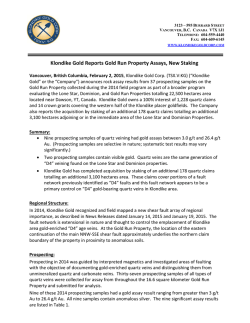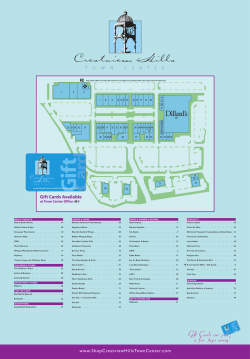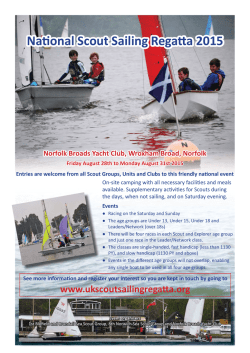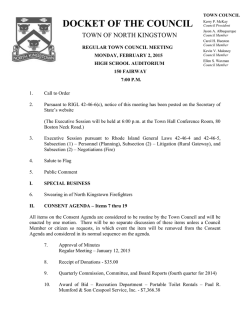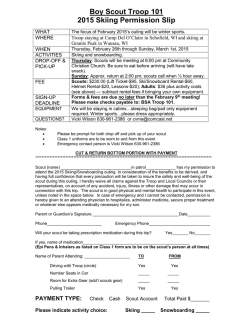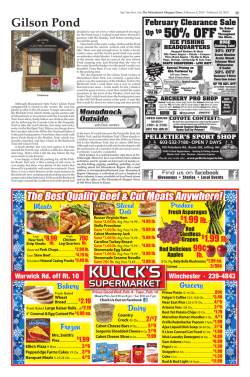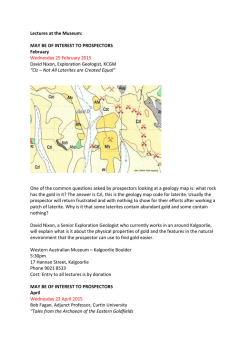
KLONDIKE DERBY - Troop 650 BSA
2015 KLONDIKE DERBY Schedule Friday, February 6, 2015 6:30 PM – 9:30 PM Registration at Handicraft pavilion (pavilion 5) 10:00 PM – 10:30 PM Patrol leaders meeting (location announced at registration) 10:30 PM – 11:00 PM Adult meeting (location announced at registration) 11:00 PM – Lights out Saturday, February 7, 2015 8:30 AM – 8:45 AM Opening at parade field 8:45 AM – 12:00 PM Klondike Derby Town Activities 12:00 PM – 1:00 PM Lunch at town of choice, judged event 1:15 PM – 4:30 PM Klondike Derby Town Activities 4:30 PM – 5:30 PM Turn in and count gold at Handicraft pavilion 5:30 PM – 5:45 PM Retire the colors – Flag field 6:00 PM – 7:30 PM Evening meal in the dining hall 8:00 PM – 10:00 PM Campfire program at old campfire ring 11:00 PM – Lights out Sunday, February 8, 2015 8:00 AM – 8:30 AM Chapel service at Chapel 9:00 AM – Sled race 10:30 AM – Closing at parade field 10:45 – Camp clean-up (per assignment) Pick up health books from health lodge. Thank you for attending and have a safe trip home. Code of Conduct for the Klondike Derby During the Klondike gold rush, there were rules to be followed and necessary provisions that prospectors had to have before they could enter the gold fields. The same holds true in order to compete in the Klondike Derby. 1. The Scout Oath, Law and Motto will govern all conduct at the event. 2. This is a cold weather event and cold weather camping rules apply. This means proper clothing, footwear and all other cold weather skills will be followed. There is a separate section in the packet to assist in preparation for cold weather camping. No tennis shoes or athletic style shoes (walking, jogging or running) are allowed on the trail. Boots are the only acceptable footwear for the Klondike. 3. If any patrol member is not properly attired, the entire patrol will be redirected to their campsite until all members are properly equipped. Any official of the Klondike can enforce this rule. 4. There will be no super patrols for the sled race. The patrol that competes on Saturday will be the same patrol that mans the sled for the race on Sunday. 5. The sled race is a timed event. All members must cross the finish line together with their sled. Partial patrols will have to pull off to the side and wait for the missing members prior to crossing the finish line. 6. All patrol rosters must be in plain sight on the sled at all times. 7. Adult Klondike staff decisions are final; there is no appeal. 8. Adult involvement with patrols will result in a deduction of gold. Adults are free to observe but cannot coach, demonstrate a skill, or otherwise assist patrols. 9. The correct way to enter a town is for the patrol leader to announce to the mayor his patrol name followed by the patrol yell. This rule, if not followed, will result in less gold earned in that town. 10. The patrol should have everything on their sled that is needed to compete in each town. If special equipment is needed to compete in a town, the mayor will provide it. Any other equipment borrowed from the town to compete will result in deduction of gold that can be earned in that town. 11. Required equipment means required equipment. (see list below) Some patrol members may not be able to participate in some towns without proper gear. Campsites are to be left cleaner than they were found. The Guide to Safe Scouting will be followed at all times. NO UNATTENDED FIRES!!! Patrol First Aid Kit (Boy Scout Handbook, Twelfth Edition) A 2 inch roller bandage 2 (two) 1 inch roller bandages A roll of 1 inch adhesive tape 24 alcohol swabs A box of assorted adhesive bandages 2 (two) 3 inch wide elastic bandages 12 sterile, 3 inch x 3 inch gauze pads 4 (four) 3 inch x 6 inch moleskin 2 packets of gel pads for blisters and burns A tube of triple antibiotic ointment 4 triangular bandages A small bar of soap or a travel-sized bottle of alcohol based sanitizing gel Scissors Tweezers 12 safety pins 6 pairs of non-latex disposable gloves Protective goggles/safety glasses CPR breathing barrier Pencil and paper Required Equipment The following tables list required equipment for the Patrol sled and for each individual patrol member to have in order to compete successfully at the Klondike Derby. This equipment checklist can be used to help each Patrol make sure they have what they need for the weekend so they should not have to borrow any equipment from town mayors. NOTE: Hot water will be available in each town and at the Handicraft pavilion. Required Patrol Equipment Each patrol should have the following equipment on their sled: Patrol roster prominently displayed on sled Patrol Flag (Scored on: Design, Workmanship, Material, Visibility and Identification) Instant soup mix packet (one Hot chocolate packet (one per per Patrol member) Patrol member) Trail food (enough for patrol member) At least 30 feet of rope Two blankets Twine for lashing Patrol first aid kit Cooking gear Paper and pencil Lunch for entire patrol 2 gallons of drinking water Pouch for gold Five large trash bags Six 6-foot staves Boy Scout Handbook Hand axe with sheath Boy Scout Fieldbook Klondike Map (for the Patrol) Matches / Fire starters (for the Two tarps (one tarp 8’ x 10’ and Patrol) one tarp 6’ x 10’) Required Essential Personal Equipment Each patrol member should have the following essential personal equipment on their person at all times: Pocket knife Totin’ chip Compass Firem’n chit Personal first aid kit Water bottle Paper and pen/pencil Extra food Rain gear (or large plastic garbage Extra clothing in Ziploc bag bag) (socks, shirt, etc.) Sun screen Flashlight or Headlamp Winter Camping Clothing (The Klondike Derby is a winter camping event and cold weather rules apply) Proper clothing is one of the most important ways to ensure your survival on a winter outing. If you are well prepared, you are warm and dry, but if you are unprepared and your feet are wet and freezing, your body loses heat dangerously fast. The survival rule: When the poorest equipped Scout becomes too cold or wet to continue, the whole patrol must stop and care for him. If the case is too severe for the Patrol to handle, the Scout, and a buddy, should seek medical attention at the Health Lodge. The Patrol may continue on the trail. If just one Scout is not adequately dressed to head out on the Klondike trail, your patrol will not be allowed to start the event until he is properly dressed for the weather conditions. The patrol may lose points due to lost time; you will have to return to your campsite to obtain proper clothing; your patrol could even be disqualified. PATROL LEADERS: This is your responsibility. Check your patrols before Friday night Troop departure and again on Saturday prior to hitting the trail. “Cotton kills” is the first rule of the winter dress code. Jeans, sweat pants, sweat shirts and some long johns are made of cotton. Cotton absorbs moisture, whether from perspiration, rain or snow and loses its ability to insulate. “Wicking” layers won’t help if the moisture flows through them to a cotton layer. No sneakers (athletic shoes). Everyone needs to have waterproof and insulated footwear for any outdoor winter activity. Be Prepared – Exceed the minimum. Remember that your boots are in contact with the ground all day long. Keeping feet warm and dry is absolutely essential. You should wear two pairs of socks - preferably polypropylene sock liner and a wool over-sock that will wick moisture away from perspiring feet. Do not wear cotton socks. Carry an extra pair of socks or shirt stored in a Ziploc bag. (SEE ESSENTIAL PERSONAL GEAR) Hats that protect your head and ears are essential for winter activities. You need warm wool or wool/poly hats that come down well over your ears. Keep your hat on (or with you). Your hat is your thermostat since most body heat is lost from your head and neck. “If your feet get cold, put on your hat and change your socks” is a good rule to remember. Mittens work better than gloves because the fingers share heat. Layering is the ideal way to cover your upper body and allows for adjustments in the thickness of insulation required for different activities. Polypropylene or wool/poly blend long underwear is the first layer. Then a poly fleece shirt or wool sweater is next. Over the shirt or sweater goes a light to medium weight jacket or “shell” depending on the weather conditions. The fourth layer (which may be in your day pack) is a rain coat or poncho to protect you from the elements. As you work harder, open up or remove layers; when you rest, zip back up or put layers back on. Finally, some inexperienced winter campers have been observed drinking “Gatorade slush” pulled from their day packs, then shivering uncontrollably. Snacks, such as Powerbars, Clif bars or granola bars, can become as hard as a rock when they are frozen. These items should be carried in an inside pocket, closer to the body. Klondike Derby Overview Gold will be awarded in the following areas: Klondike Course (up to 50 per town): Gold can be earned in each town along the Klondike trail. All skills and information are from the Boy Scout Handbook and will be skills covered in ranks up through First Class. Skills will be anything from knots and lashing, first aid, navigation, nature, wood tools, cooking, teamwork, tree identification and/or camp craft. Remember the words of the founder of Scouting, Lord BadenPowell about being prepared and being observant; the most prepared and observant are the most successful. What might a patrol encounter along the Klondike trail? Sled inspection: (up to 45) Gold can be earned for sled inspection based on how much of the Required Patrol & Personal Equipment is included on the sled. Mountie questions: (up to 55 points) Mounties will ask a total of 15 questions. Five Scout related questions (5 points each): These will come from the current Scout Handbook and cover the Scout requirements through First Class Ten Klondike history questions (3 points each): These will come from the Klondike History portion of the 2015 Klondike Packet. Special Character Section: (up to 20 points) Skookum Jim will be at the Klondike and can be found somewhere along the trail. Finding him will be worth up to 20 points. (The correct way to address Skookum Jim is: “Are you Skookum Jim, the prospector from Tagish?”) The first patrol to identify Skookum Jim will be awarded 10 pieces of gold. That Patrol will then be asked five character specific questions worth two points each for a possible 10 points. Under the rank of First Class Scout: (2 points each) Patrol leaders will locate the governor of the Klondike, Mr. Austin McGee and will give him the names and ranks of these patrol members. This is the patrol leader’s responsibility and if the patrol leader fails to provide this information, the patrol will miss out on gold. Lunch (up to 15 points) At noon you will prepare a trail lunch. If you are on your way to the next town at this time, proceed to that town and check in with the mayor. If you are ready to leave a town, stay there and prepare lunch. The trail lunch will be prepared by the Patrol and will feed each Patrol member. Everything needed to prepare the lunch should be on the patrol sled, including water. For anything borrowed from the town, gold will be deducted. When everyone is finished with lunch, clean up your cooking and eating areas. Clean up includes proper washing of utensils, bagging trash and stowing gear. Again, if anything (trash bags or soap) is borrowed from the town or if you do not have these items, your gold count will be affected. Incorporate Leave No Trace Principles. The lunch gold count will be based on teamwork, quality of meal and meal clean-up. Klondike Skit (up to 15 points) The Klondike skit will be one skit per Troop. Gold awarded for the skit will be the amount of gold awarded for each patrol in the Troop (if the troop is awarded 15 gold nuggets for the skit, each patrol in the troop will be awarded 15 gold nuggets). The theme of the skit is cheese sandwiches. The skit must have “cheese sandwiches” incorporated into it and have a Klondike gold rush theme. Including both of these items will help the Troop earn more gold for their skit. This will be easy if you are observant. Again, all information needed to come up with a successful skit can be found in this Klondike packet. The skit will be judged on originality, teamwork and how well it incorporates the Klondike gold rush and “cheese sandwiches” theme. Good luck! Klondike Gold Rush History Prior to 1896, only the First Nations peoples and the hardiest of fur traders, prospectors, missionaries and Northwest Mounted Police ventured into the Yukon Territory. In two short years, the landform, people and the history of the Yukon would be changed forever. According to the oral traditions of the Tagish First Nations peoples, the gold rush began when Skookum Jim, Dawson Charlie and his wife Patsy Henderson traveled down the Yukon River from Tagish, in the southern Yukon. They were searching for Jim’s sister, Shaaw Tiaa, also known as Kate, and her husband George Carmack. After locating he couple in July, 1896, Jim and the others were fishing on the Klondike River when veteran gold prospector Robert Henderson approached George and related to him about some gold that he had found in Gold Bottom Creek in the Klondike River Valley. The unwritten code of the gold prospectors of the region, Henderson had to share his knowledge with whomever he met. Carmack asked if he could stake a claim. In a voice overheard by Jim and Charlie, Henderson replied to George that he could stake a claim but Skookum Jim and Dawson Charlie could not. This statement, Henderson later recalled, “cost me a fortune.” Jim and Charlie panned out a few traces of gold from Rabbit Creek in August of 1896. In a place where the bedrock was exposed, someone found a nugget the size of a dime. Energized by this find, Jim, Charlie and George turned over loose pieces of rock and found gold that, according to Carmack, “lay thick between the flaky slabs like cheese sandwiches.” The date was August 16, 1896 and the rush for gold was on. George Carmack, Jim and Charlie staked their claim the following day and renamed the creek Bonanza. They never told Robert Henderson and by the time he heard of the discovery, the best locations on Bonanza Creek had all been staked. News of the gold find reached the outside world in the spring of 1897, when the steamer ship, the SS Portland, sailed into the port of Seattle, carrying a “ton of gold” – this according to the local newspaper. The fact is that the ship carried more than two tons of gold. The “ton of gold” phrase was wired to newspaper around the world, and soon thousands of people who had never dreamed of prospecting for gold and knew nothing about the trade, dropped everything and outfitted for the Klondike. Even the mayor of Seattle resigned his position and headed north. A staking rush was on. The gold finds at El Dorado Creek, a tributary of Bonanza yielded over 30 million dollars of gold despite the fact that it was no more than five miles long. It is a matter of speculation as to why the Klondike Gold Rush captured the imagination of so many people. Perhaps, it had to do with the world being in a recession at this time and the press eagerly writing and reporting of the sensational wealth to be had in the Klondike region. The media helped to create the idea of a land where riches just lay in the ground for anybody to dig up and carry away. The truth was that reaching the Klondike was far more difficult than most stampeders ever thought. There were three major routes heading north with many considering the water route the easiest. The water route was very expensive and nearly impossible to book passage. For prospectors with money, it offered what seemed to be a comfortable, though long, steam ship journey. The trip was 3000 miles from Seattle to the port of Saint Michael, then another 1700 miles up the Yukon River to Dawson City where stakes were claimed. The conditions on most of the steamers were crowded and filthy, and few had expected that the waters would be as difficult to navigate as they found the Yukon River. Very few of the prospectors that chose this route met the provisions requirement to make the journey. One year’s worth of supplies was required before being allowed entry to the Klondike area. The majority of the ships/boats were frozen in the Yukon and had to wait for spring to thaw the icy seas before they could move again. The Trails The Chilkoot Pass and White Pass were the two major land routes to the gold areas. White Pass seemed to be the less arduous of the trails over the mountains than did the steep Chilkoot Pass. The truth was neither of the routes was easy to travel. Winter travel meant thick snow and treacherous ice. Spring was no different as the prospectors, animals, wagons and sleds sloshed through thick, unending mud. Even traveling the routes in the summer, gold seekers had to traverse along trails littered with sharp, jagged rocks. After a deadly avalanche killed dozens along Chilkoot Pass, town promoters in Skagway boasted that their trail was proven to be safer. The Northwest Mounted Police were stationed at the summits of each trail. They were performing two functions, collecting duty (tax) on incoming goods and to ensure that everybody was outfitted to survive one year in the Klondike region. “Be Prepared” was practiced even this early. Being prepared meant having one ton of goods per person. These provisions included food, shelter, cooking utensils and tools. When possible, the stampeders used animals and sleds to move along the trails; long portions of the trails were so narrow or in such poor condition that goods had to be carried in 50 to 60 pound packs strapped to the prospector’s back. In this manner, goods were moved slowly, about 5 miles per trip. After stashing their goods by the sides of the trails, men and women would walk back to the starting point and repeat this process. A prospector would walk 80 miles for every mile they moved their provisions. Those with money would hire packers and freighters to move their goods; most carried their boxes of goods on their own. Starting from Skagway, the first several miles of White Pass were on good roads wide enough for pack animals. This section had a gentle, upward grade. After this section, the prospectors encountered a series of narrow climbs on rocky switchbacks; this earned White Pass the dubious name “Dead Horse Trail” because of the hundreds of pack animals that died on the trail. An interesting fact about Skagway during the height of the gold rush is that it was home to the most prolific con man of the region. Jefferson “Soapy” Smith and his gang of con men ruled the town with all manner of cons. The most famous of his cons involved his offer of sending telegrams home for a cost of 5 dollars; prospectors never thought to look behind “Soapy’s” telegraph operation. Had they investigated, they would have found that there were no telegraph lines after a few yards. As Skagway used the avalanche on Chilkoot, Dyea civic promoters used stories of “Soapy” and his gang to lure stampeders from Skagway to their town. The Chilkoot Pass earned the nickname of “the meanest 32 miles in the world.” The trail began just north of Skagway at Dyea. The Pass had very steep grades but it was also the most expedient route to the gold fields. Approximately 22,000 people attempted the trail during the fall of 1897. A human chain stretched across the entire length of the Pass and anybody stopping to rest was often unable to reenter the line for hours. The worst part of the trail was between Sheep Camp and Scales, the “Golden Stairs.” The “Golden Stairs” were 1500 stairs carved out of ice along a 2 ½ mile section of the trail that rose 1600 feet. Prospectors moved up the stairs in a single line, clutching rope balustrades and carrying 50 to 60 pound packs on their backs. A deadly avalanche killed dozens along the Chilkoot Pass. The word stampede was laughable under these crowded, slow moving conditions. A single trip up the “Golden Stairs” could take as long as six hours; the trip down was much easier. A series of slides were carved in the ice near the stairs enabling people to slide down in about three minutes. From the 3739 foot Chilkoot Pass, the stampeders hiked to Lake Bennett where they would construct boats to navigate the 500 miles on the Yukon River to Dawson City. Founded in the early days of the gold rush, Dawson City boomed from a tent city of 500 in 1896 to 30,000 in 1898, its heyday. It was known as the “Queen City of the North” during this era. Upon reaching Dawson City, prospectors learned that most of the productive claims had been staked two years earlier. Many turned back; some stayed and found their wealth selling goods and services to other miners. More wealth was generated through merchants than through the mining for gold, an irony of the gold rush. Estimates state that 100,000 gold seekers left for the Klondike. By winter of 1897, very few arrived at Dawson City. The few who did found the town ill prepared and they faced starvation. Less than half of the prospectors reached Dawson the following fall, briefly transforming the city into a boomtown. A small fraction upon arriving had any desire to look for gold, after learning that all good claims were already staked; the cost of living was high and mining was hard work. Only a handful of people, with the exception of the original prospectors from 1896, made any fortune during the gold rush peak of 1896 to 1897. The Klondike Gold Rush ended as quickly as it started. In 1899, after gold was found on the sandy beaches of Nome, Alaska, many who had arrived late to the Klondike left immediately for these new gold fields or the “New El Dorado” as it was so named. Ironically, the greatest gold producing year in the Yukon was 1900 when $22 million worth of gold was extracted. The largest yields for the Klondike were $2.5 million in 1897 and 10 million dollars in 1898.
© Copyright 2026
